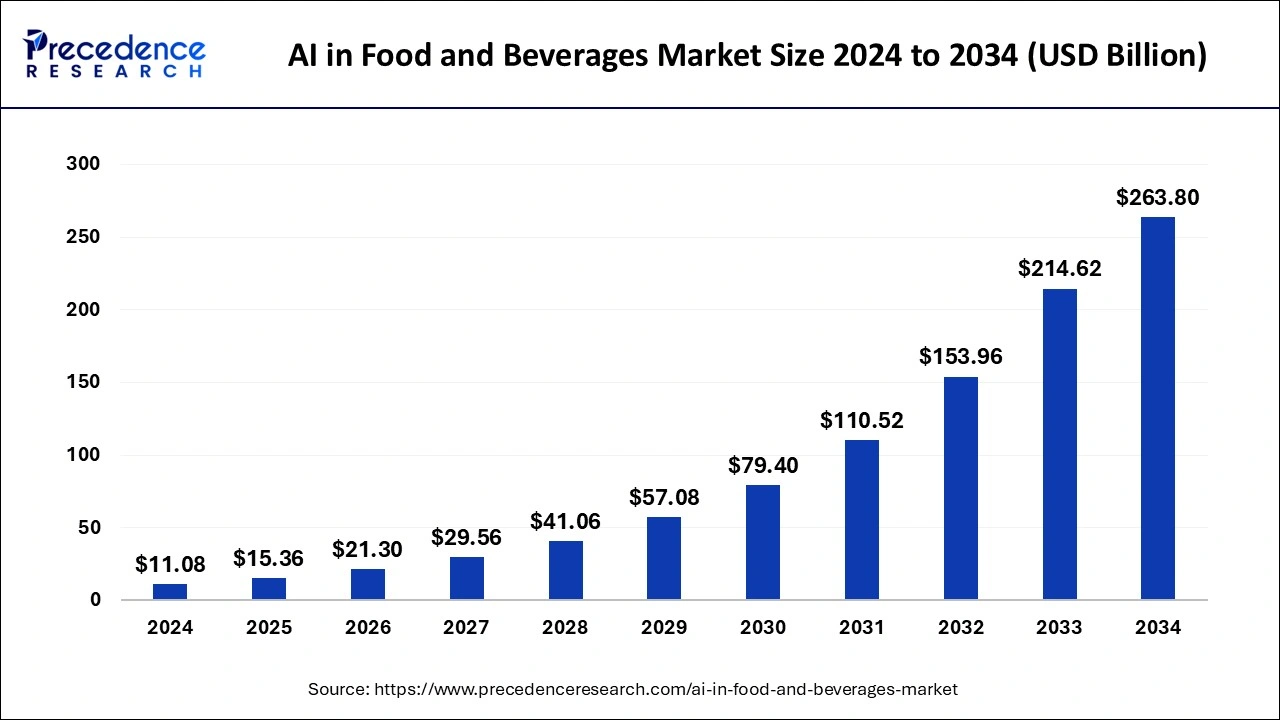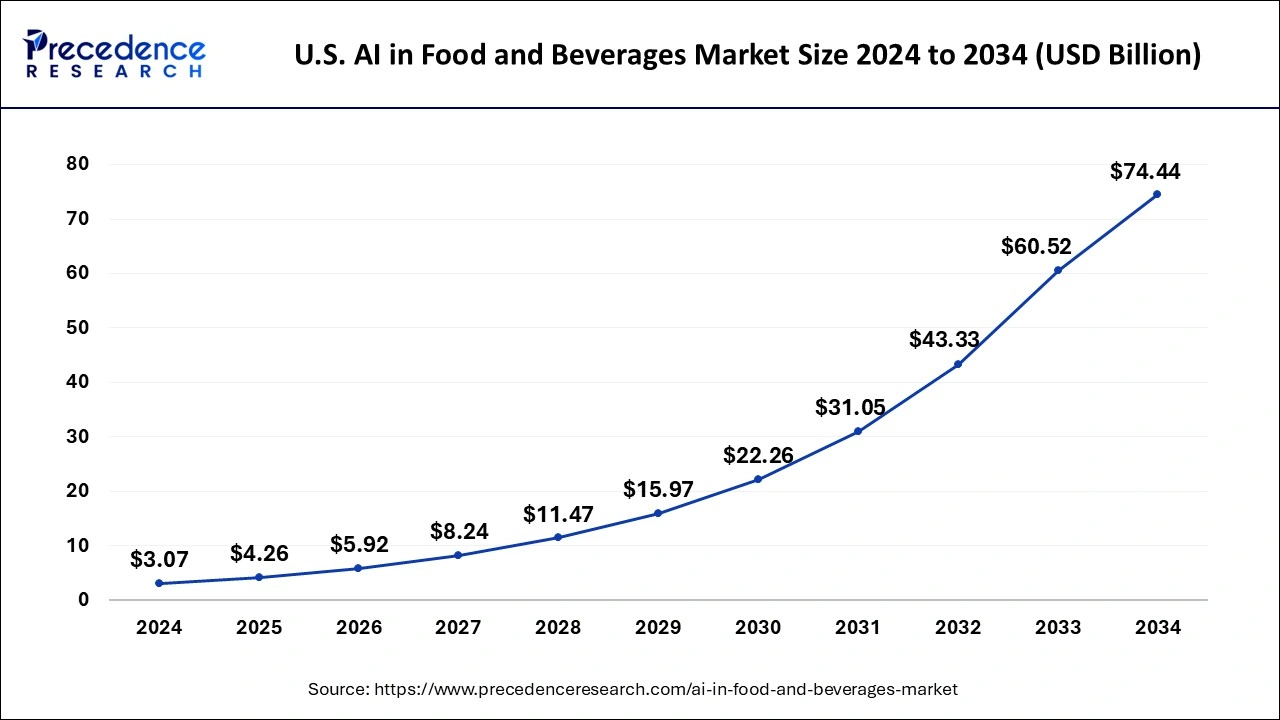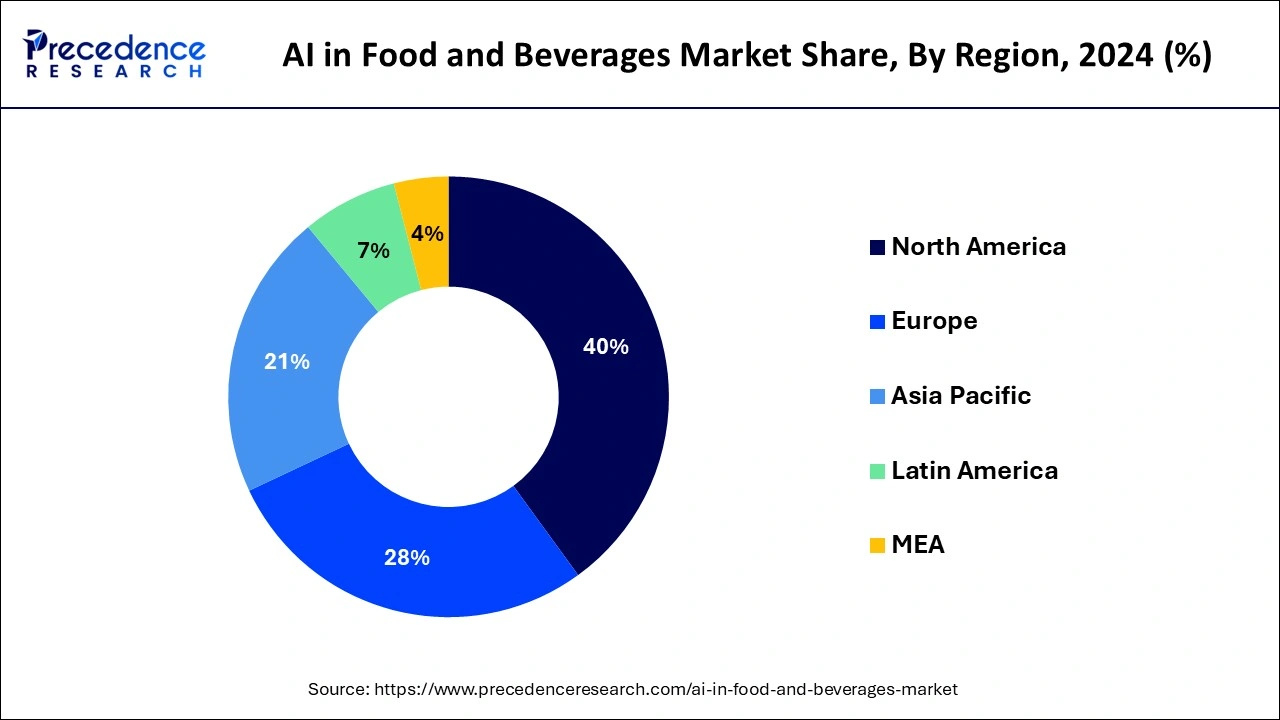January 2025
The global AI in food and beverages market size is calculated at USD 15.36 billion in 2025 and is forecasted to reach around USD 263.80 billion by 2034, accelerating at a CAGR of 37.30% from 2025 to 2034. The North America AI in food and beverages market size surpassed USD 4.43 billion in 2024 and is expanding at a CAGR of 37.31% during the forecast period. The market sizing and forecasts are revenue-based (USD Million/Billion), with 2024 as the base year.
The global AI in food and beverages market size was estimated at USD 11.08 billion in 2024 and is predicted to increase from USD 15.36 billion in 2025 to approximately USD 263.80 billion by 2034, expanding at a CAGR of 37.30% from 2025 to 2034. AI is responsible for revolutionizing the food industry and is capable of improving personalized nutrition, efficiency, and data-driven decision-making.

The U.S. AI in food and beverages market size was estimated at USD 3.07 billion in 2024 and is anticipated to reach around USD 74.44 billion by 2034, growing at a CAGR of 37.55% from 2025 to 2034.

North America led the market with the biggest market share of 40% in 2024. It is estimated that North America will continue its dominance in the market in the coming years. The United States in North America is a global center for technological innovation. Technology firms and academic institutions that help create AI solutions in the food and beverage industry are leading. North America has a robust ecosystem for research and development, which makes it a leading AI region in the food and beverage market. North America also provides substantial financial support for AI startups and enterprises.

Major advancements in North America AI in food and beverages market
The growth of AI in the food and beverages market is expanding in Asia Pacific. There are ongoing technological advancements in this region, due to which it has potential. Increased connectivity, globalization, and tech-savvy consumers are responsible for the rapid group.
The simulation of human intelligence in machines, especially in computer systems, which usually require human intervention, is AI. It is used to enhance the efficiency and performance of machines. In the case of the food and beverages industry, AI can be used in different sectors, including product and packaging, industrial standards compliance, quality control, consumer engagement, food and sorting applications, and meal transportation.
AI in food and beverages market ensures optimal quality, excellent hygiene standards, and efficiency, retains nutritional value, reduces wastage, detects microorganisms, minimizes overproduction, and timely delivery. There are many more applications of integrating AI in food and beverages market. It can help reduce workload, optimize workflow, innovation in product development, improve process flow, and ultimately lead to consumer satisfaction.
Customer Services
It is crucial to analyze customers' preferences and achieve the highest level of customer satisfaction in hotels and restaurants, which can be achieved by integrating AI into customer services. Menu optimization will be helpful in improving efficiency and dining experience. AI can help in providing suggestions based on upselling items or the most popular choices. Based on customer reviews and feedback, AI will be able to identify areas that need improvement.
AI-powered reservation systems can automate the entire system of reservations and wait time. It will include reservation taking, cancellations, and updating waitlists. AI-powered systems can optimize eating capacity and table turnover based on historical data and future predictions. AI-powered customer management systems can manage customer relations. It can analyze previous orders and preferences and provide personalized recommendations.
AI-powered robot waiters
The use of robot waiters can be traced back to 1983 by Two Panda Deli, a restaurant based in California. However, the robots used in restaurants usually break down and are not suitable for carrying out specific tasks. Robot waiters powered by AI will be capable of carrying out food and beverage delivery and reception and can interact with the customers.
Culinary innovation
Integration of AI in kitchen appliances and culinary applications can revolutionize the way home cooking is done. It can provide cooking assistance, personalized recipes, and flavor profiting.
Microplastic detection with AI
Microplastics are small pieces of plastics that enter the human body and are severely harmful to health. AI tool called PLasticNet was developed by researchers. It is capable of detecting/scanning microplastic 50% faster than the pre-existing methods and has 20% more accuracy. The accuracy level is achieved by training the AI tool on more than 8,000 spectra of virgin plastic.
AI can also help improve the nutritional value of food by identifying new food sources which are rich in bioactive compounds and specific nutrients. This will help in developing healthy food and diet plans, leading to the reduction of chronic disorders such as cardiovascular diseases, diabetes, obesity, and more.
| Report Coverage | Details |
| Growth Rate from 2025 to 2034 | CAGR of 37.30% |
| Market Size in 2025 | USD 11.08 Billion |
| Market Size by 2034 | USD 263.80 Billion |
| Base Year | 2024 |
| Forecast Period | 2025 to 2034 |
| Segments Covered | By Technology, By End-user, and By Application |
| Regions Covered | North America, Europe, Asia-Pacific, Latin America, and Middle East & Africa |
Food safety improvement and enhancing customer experience
A significant driver of AI in food and beverages market is improvement in food safety. Many manufacturers are adopting automation in the industry to meet guidelines and regulations. It is also essential to have the system in the company for the analysis of hazards and risk-based preventive controls. Food and beverage companies are expected to have a system for proper documentation of the process implemented that is useful in demonstrating that the companies are meeting the legal criteria.
Hence, safety is a significant driver of AI in food and beverages market. Another key driver is customer experience, which can be enhanced by incorporating AI in different segments of the food and beverage industry. Hotels and restaurants can use AI in menu optimization and other customer services. Food delivery apps can incorporate AI to enhance user experience while using their applications.
Improving efficiency
Enhancing efficiency is also a driver of integrating AI in food and beverages market. AI can make different processes such as applied chain management, product packaging, and delivery, interacting with end users, and many other processes efficient by analyzing issues in the system or process and also by providing innovative ideas to tackle them.
Extensive data collection and processing
There are several restraints that can hinder the integration of AI in food and beverages market. One of the challenges is that AI needs comprehensive data capture and management. A large amount of data is required for training and improving algorithms.
Data threat and high infrastructure and training costs
It becomes difficult to protect such a large amount of data from cyber threats. Companies have existing systems, and integrating AI into those systems can be time-consuming and complex. A lot of investment is needed for new infrastructure or modification of existing systems. AI in food and beverages market is comparatively new due to which industries operate AI-based systems. Proper knowledge and practice are needed to use such systems.
Enhancing customer satisfaction
The food and beverage industry is customer-centric and, therefore, important to customer satisfaction. There is a vast scope for AI integration to enhance customer satisfaction by analyzing dietary restrictions, consumption patterns, and individual preferences. It will be helpful and provide advanced culinary experience, which can be achieved by providing personalized recommendations for restaurants and food. Menu optimization is an excellent opportunity for all food chains and restaurants to use Air to enhance customer experiences.
In 2024, the machine learning segment dominated the AI in food and beverages market. Algorithms of machine learning are implemented in different processes for predicting demand, optimizing supply chain processes, optimizing inventory levels for proper logistics and distribution, enhancing end-user experience, and increasing efficiency. Machine learning is instrumental in reducing cost, reducing waste, and improving the overall efficiency of the entire process. Machine learning is integrated into systems for analyzing popular trends, customer preferences, and historical data for menu optimization.
Followed by machine learning, the robotics and automation segment is showing a significant growth rate in the forecast period of 2024-2033. Robots integrated with AI learning are helpful in different tasks conducted in food and beverage companies and agriculture and can even be used in restaurants as waiters.
The food manufacturing segment had the largest market share and led the market in 2024. The segment has a very high potential to grow in the coming years. Integrating AI in food and beverage manufacturing processes is highly useful in optimizing supply chain processes by predicting demands, efficiently managing inventory, and improving overall logistics. The efficiency of manufacturing food and beverages can be increased by using AI-driven robotics and machine learning in regular operations and procedures.
These operations are packaging, handling, sorting, and delivery, which can reduce human labor for jobs that are challenging for humans. AI can also help in saving energy. Intelligent energy management systems can be developed with the help of AI algorithms to improve energy, lower expenses, and have a sustainable impact on the environment. Utilization of resources can be maximum, waste generation can be reduced, and the burden on the environment can be reduced by implementing AI-based sustainable practices.
Followed by food and beverage manufacturing, the restaurant segment has the potential of the fastest rate of expansion in the AI in food and beverages market in the forecast years 2024-2033. AI is already integrated into menu optimization, staff and restaurant process management, chatbots, and AI robots. These are essential to analyzing customer preferences and providing personalized menu recommendations, leading to customer satisfaction. Staff and process management are helpful in time management, waste management, and waste reduction.
In 2024, the food processing segment dominated the AI in food and beverages market. It is estimated that there will be notable growth in this segment in the upcoming years. AI systems are helpful in better traceability of food and beverage products in the overall processing journey. The technology is beneficial in properly identifying affected batches and enhancing food safety. In food processing, equipment is also useful as it facilitates predictive maintenance. Data analysis via machinery and sensors powered by AI is useful in predicting maintenance requirements, minimizing downtime, and predicting disruptions in the processing line.
Rapid growth during the forecast period can be observed in the supply chain management segment. AI tools are useful in automation inventory management by continuous monitoring of expiry dates, stock levels, and other factors. The supply chain can be managed appropriately to minimize stock out and reduce access inventory holding costs.
ICT Foods is focusing on integrating AI technology in their dairy and beverages supply chain. The company will include AI-powered machine learning algorithms and sensors for monitoring and maintaining product quality during the production process. It will ensure product quality with the help of different tools like real-time monitoring systems, visual inspection systems, and feedback mechanisms.
The integration of AI is becoming highly advanced in the food and beverage sector. In the future, AI-based technology can be developed for making DNA-based menus. DNA, blood tests, or microbiota can be used to design special nutritional supplements or diets. It will be more beneficial for people with allergies, dietary restrictions, and intolerance. LaBe restaurant in San Sebastian, Spain, developed a project in which the menu was based on the genetic profile of the customers. However, it can pose challenges while collecting data due to the last population size and unique DNA.
By Technology
By End-user
By Application
By Geography
For inquiries regarding discounts, bulk purchases, or customization requests, please contact us at sales@precedenceresearch.com
No cookie-cutter, only authentic analysis – take the 1st step to become a Precedence Research client
January 2025
August 2024
July 2024
April 2024